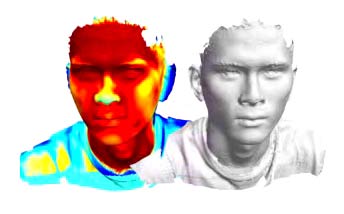New method of identification by person
Today, the threat of theft of confidential data is particularly relevant. Everywhere, where we are forced to confirm our identity, different methods of identification are used - digital codes, images, access passwords, etc. In addition, biometric identification methods such as fingerprints, which, say, can be used to access information stored in a laptop, are becoming popular. There are much more complex methods of biometric identification, for example, face recognition. However, this method is not very common due to the fact that people often change their appearance, for example, they change their hairstyle or wear dark glasses.
A research team from the University of Houston reported on a new face recognition method that can make this identification method very accurate. The technology includes 3D sensors, infrared cameras and a special program called URxD. The program takes a three-dimensional image of a person and creates a unique biometric identifier. Despite the fact that creating a unique identity identifier takes no more time than taking a picture of someone, the production process is rather complicated. The URxD program uses cameras to create a three-dimensional model of a person, then imposes on it the texture and data obtained by an infrared camera.
The main difference of this technology from all previously existed is how the infrared camera is used. Data obtained from this device is used to separate facial features from third-party objects, such as a hat or adhesive plaster. Thus, an identifier can be “deceived” only by making a plastic operation.

According to testing data, the program is able to correctly recognize people in 99.6% of cases. Unfortunately, the high cost of technology does not allow it to become a mass. Only one 3D sensor, which is necessary for the operation of the URxD, costs 20 thousand dollars. However, the creators of technology are optimistic and say that in the coming years, the sensors have all the chances to fall in price and decrease in size. As for the power required for data processing, today's computers can easily cope with the creation of a biometric 3D-identifier in a few seconds.
Via 3dnews
A research team from the University of Houston reported on a new face recognition method that can make this identification method very accurate. The technology includes 3D sensors, infrared cameras and a special program called URxD. The program takes a three-dimensional image of a person and creates a unique biometric identifier. Despite the fact that creating a unique identity identifier takes no more time than taking a picture of someone, the production process is rather complicated. The URxD program uses cameras to create a three-dimensional model of a person, then imposes on it the texture and data obtained by an infrared camera.
The main difference of this technology from all previously existed is how the infrared camera is used. Data obtained from this device is used to separate facial features from third-party objects, such as a hat or adhesive plaster. Thus, an identifier can be “deceived” only by making a plastic operation.

According to testing data, the program is able to correctly recognize people in 99.6% of cases. Unfortunately, the high cost of technology does not allow it to become a mass. Only one 3D sensor, which is necessary for the operation of the URxD, costs 20 thousand dollars. However, the creators of technology are optimistic and say that in the coming years, the sensors have all the chances to fall in price and decrease in size. As for the power required for data processing, today's computers can easily cope with the creation of a biometric 3D-identifier in a few seconds.
Via 3dnews
')
Source: https://habr.com/ru/post/12865/
All Articles